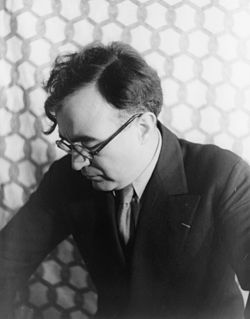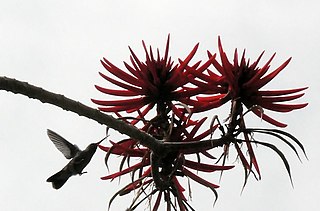
String Quartet No. 3 is a chamber-music work written in 1931 by the Mexican composer and violinist Silvestre Revueltas.

String Quartet No. 3 is a chamber-music work written in 1931 by the Mexican composer and violinist Silvestre Revueltas.
Revueltas composed his third string quartet in the same year as his second, 1931, and the Cuarteto Clásico Nacional gave the first performance on 2 September 1931. [1] Although the score was announced in 1958 as being "in preparation for sale", [2] it was only finally published in 1995, fifty-five years after the composer's death and several decades after his other three quartets. [3]
The quartet is in three movements:
This work is regarded as "the best, most solid, and profound" of Revueltas's quartets. The second movement, marked "mysterious and ghostly", contains references to the third movement of Béla Bartók's Fourth Quartet, which was written just three years earlier. [4]

Silvestre Revueltas Sánchez was a Mexican composer of classical music, a violinist and a conductor.
Santiago Vera-Rivera is a Chilean composer, teacher and musical researcher.

Cuarteto Latinoamericano is one of the world's most renowned string quartets and, for forty years, the leading proponent of Latin American music for the genre. Founded in Mexico in 1982, the Cuarteto has toured extensively throughout Europe, North and South America, Israel, China, Japan and New Zealand. They have premiered over a hundred works written for them, and they continue to introduce new and neglected composers to the genre. Winners of two Latin Grammy Award for Best Classical Album, they have also been awarded with the prestigious Diapason d'Or, have been recognized with the Mexican Music Critics Association Award, and have received three "Most Adventurous Programming" Awards from Chamber Music America/ASCAP.

Homenaje a Federico García Lorca is a work for chamber orchestra by the Mexican composer Silvestre Revueltas.

Sinfonía india is Carlos Chávez's Symphony No. 2, composed in 1935–36. In a single movement, its sections nevertheless follow the traditional pattern for a three-movement symphony. The title signifies the fact that the thematic material consists of three melodies originating from native-American tribes of northern Mexico. The symphony is Chávez's most popular composition.

Janitzio is a symphonic poem by the Mexican composer Silvestre Revueltas, composed in 1933 and revised in 1936. A performance lasts about fifteen minutes. The work is a portrait of Janitzio Island in Lake Pátzcuaro, Mexico.

Colorines is a symphonic poem for chamber orchestra by the Mexican composer Silvestre Revueltas, written in 1932.
Salvador Contreras Sánchez was a Mexican composer and violinist, a member of the Grupo de los cuatro.

Planos (Planes) is a chamber-music composition by the Mexican composer Silvestre Revueltas, also slightly enlarged and scored for full orchestra and published under its alternate title, Danza geométrica. Both versions were composed in 1934, and the scores are both dedicated to the architect Ricardo Ortega.

Cuauhnáhuac is an orchestral composition by the Mexican composer Silvestre Revueltas. It exists in three versions, the first for string orchestra, the other two for full orchestra with winds and percussion. The first version takes nearly 15 minutes to perform, while the third lasts only about 11 minutes.

Música de feria is a composition for string quartet by the Mexican composer and violinist Silvestre Revueltas, written in 1932. Though not so titled by the composer, it is sometimes referred to as his String Quartet No. 4. A performance lasts a little more than nine minutes.

String Quartet No. 1 by the Mexican composer and violinist Silvestre Revueltas was composed in 1930.

String Quartet No. 2 (Magueyes) is a chamber-music work by the Mexican composer and violinist Silvestre Revueltas from 1931. The score is dedicated to Aurora Murguía and a performance of it lasts between ten and eleven minutes.

String Quartet No. 4 is the fourth of seventeen works in the genre by the Brazilian composer Heitor Villa-Lobos, written in 1917 and revised in 1949. A performance lasts approximately 23 minutes.

String Quartet No. 10 is one of a series of seventeen works in the genre by the Brazilian composer Heitor Villa-Lobos, and was written in 1946. A performance lasts approximately 23 minutes.

String Quartet No. 11 is the one of a series of seventeen works in the medium by the Brazilian composer Heitor Villa-Lobos, and was written in 1947. A performance lasts approximately 27 minutes.

String Quartet No. 13 is one of a series of seventeen works in the medium by the Brazilian composer Heitor Villa-Lobos, and was written in 1951. A performance of it lasts approximately twenty minutes.

String Quartet No. 16 is the penultimate of seventeen quartets by the Brazilian composer Heitor Villa-Lobos, and was written in 1955. A performance lasts approximately twenty minutes.

String Quartet No. 17 is the last of seventeen quartets by the Brazilian composer Heitor Villa-Lobos, and was written in 1957. A performance lasts approximately twenty minutes.
Sources